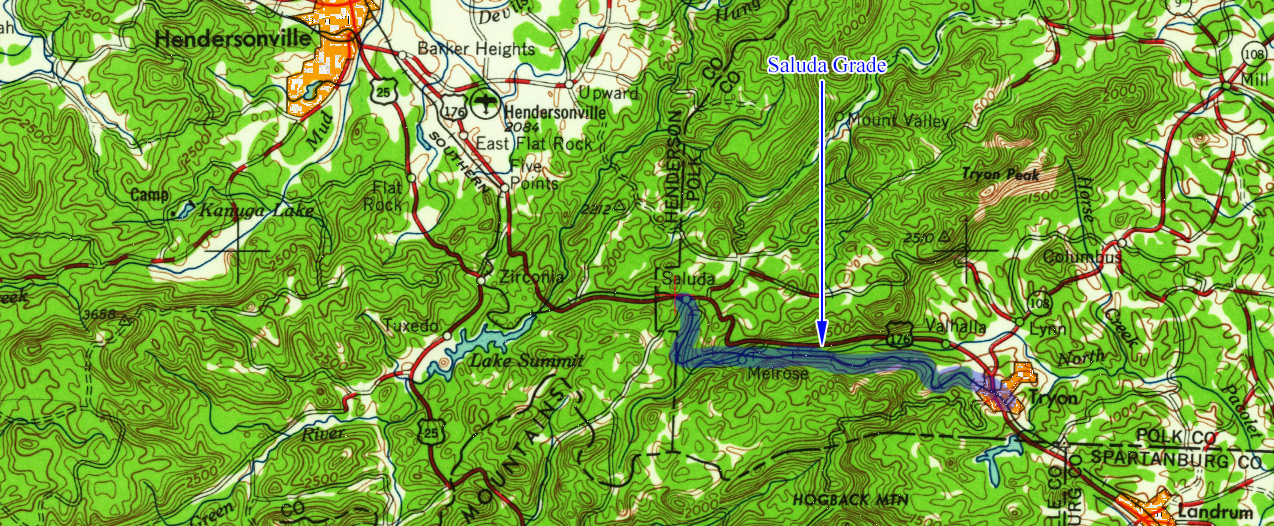Saluda Railroad Grade (NC): Map, History, Trail
Last revised: August 24, 2024
By: Adam Burns
Saluda Grade was the steepest standard-gauge mainline railway grade in the United States. Located in Polk County, North Carolina, it was part of the Southern Railway and a vital link for trains traveling between the Piedmont region and Asheville.
The grade, which has a slope of 4.7%, was known for its challenging conditions and was the site of numerous train accidents. It was closed in 2001 due to safety concerns.
From an engineering and
railroad perspective, Saluda Grade was one of
the scariest and most daunting sections of main line anywhere in the
United States.
The line was originally constructed in the 1870s to connect Spartanburg, South Carolina with Asheville, North Carolina. It was built through the rugged Blue Ridge Mountain range. Unforutnately, engineers could find no suitable grades west of Tryon and were forced to lay a grade along the Blue Ridge front of between 4-5%.
Such an ascent is nearly unheard of for a main line railroad. Surprisingly, however, this corridor remained in service until December, 2001, at which time it was recognized as the steepest main line railroad in the United States.
To reduce the chance of runaways, a safety spur was installed (a type of runaway ramp often employed on steep highway grades for trucks) at the bottom of the hill.
In addition, trains were often required to "double the hill," a railroad expression involving cutting the train into two sections. Interestingly, this was done in both directions due to the grade's severity.
After retaining ownership of the mothballed property for 22 years, Norfolk Southern finally agreed to sell 31 miles of the route to The Saluda Grade Trail Conservancy, which plans to convert the property into a recreational trail.
Photos
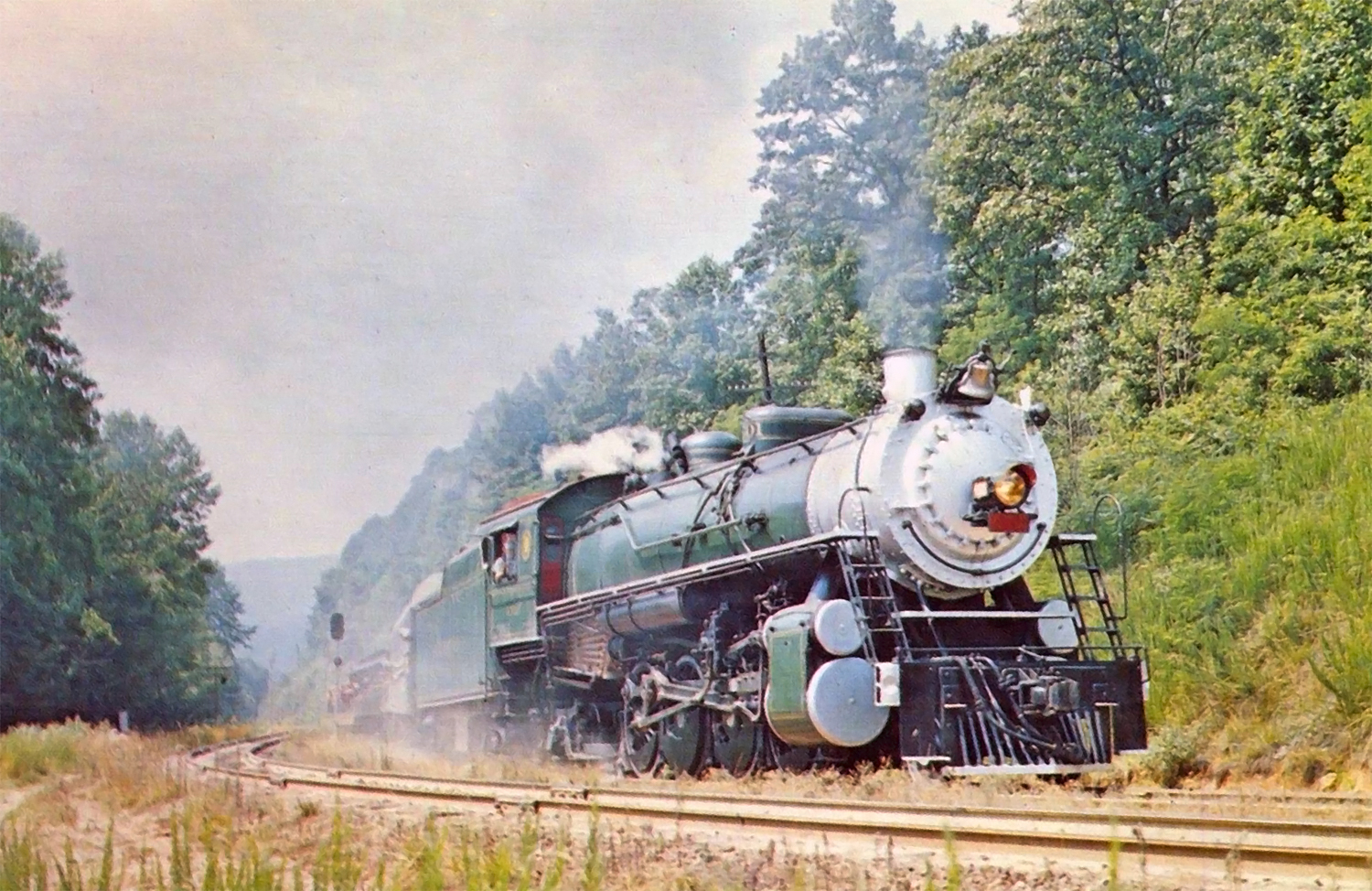 Southern Railway 2-8-2 #4501 climbs 4.7% Saluda Grade with a fan trip at a location known as Stop Board #2 on July 8, 1972. A.M. Langley, Jr. photo.
Southern Railway 2-8-2 #4501 climbs 4.7% Saluda Grade with a fan trip at a location known as Stop Board #2 on July 8, 1972. A.M. Langley, Jr. photo.History
The Southern Railway was created from a number of smaller railroads in the late 19th century. It is widely regarded as one of the most lucrative railroads in the nation and was still enjoying strong profits into the 1970s, a time in which much of the industry was struggling.
Perhaps, then, its famous Virginia Green paint scheme was fitting as it was one of the most respected, and arguably best managed, railroads of its day. In 1982 it merged with the Norfolk & Western forming today's Norfolk Southern Railway.
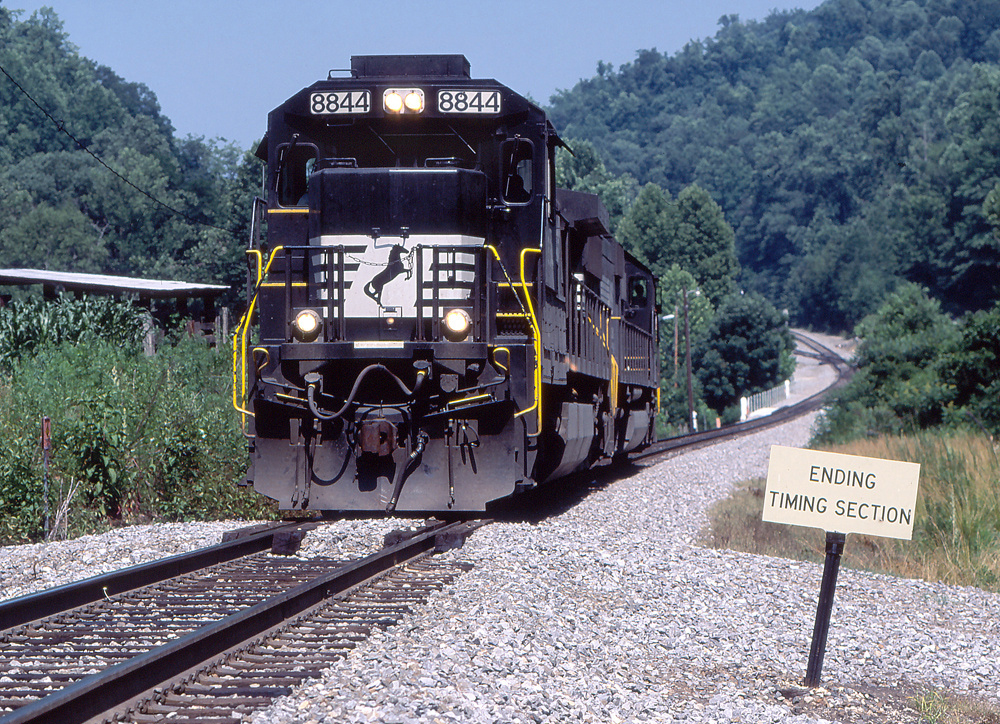 A pair of Norfolk Southern units, led by C40-9 #8844, prepares to make another run up Saluda as the locomotives return to the summit for a second cut of cars from Melrose, North Carolina on June 22, 1996. Wade Massie photo.
A pair of Norfolk Southern units, led by C40-9 #8844, prepares to make another run up Saluda as the locomotives return to the summit for a second cut of cars from Melrose, North Carolina on June 22, 1996. Wade Massie photo.Construction
What became Saluda Grade was
designed by Charles W. Pearson who engineered the route of the
Spartanburg & Asheville Railroad between its namesake cities.
Surveying northward from Spartanburg, Pearson found that the soft, rolling hills of southern North Carolina's Piedmont region suddenly crashed into the Blue Ridge Mountain range.
Map
Try as he might, Pearson and his engineering crew could not find a suitable, manageable grade up the mountainside (something at least hovering around 2%, which was still quite stiff for daily railroad operations).
Beginning at Melrose Mountain near what is now Tryon, North Carolina the line was surveyed on a westward track towards the small town of Saluda.
The grade chosen proved quite tortuous with one 3-mile section topping out at 3.787% while other segments were even worse, ranging between 4.7% and 5.1%. As a result, these grades earned it the distinction as the steepest standard-gauge main line railroad in the United States. Typically, such grades are only found in logging or branch line operations, never a through route!
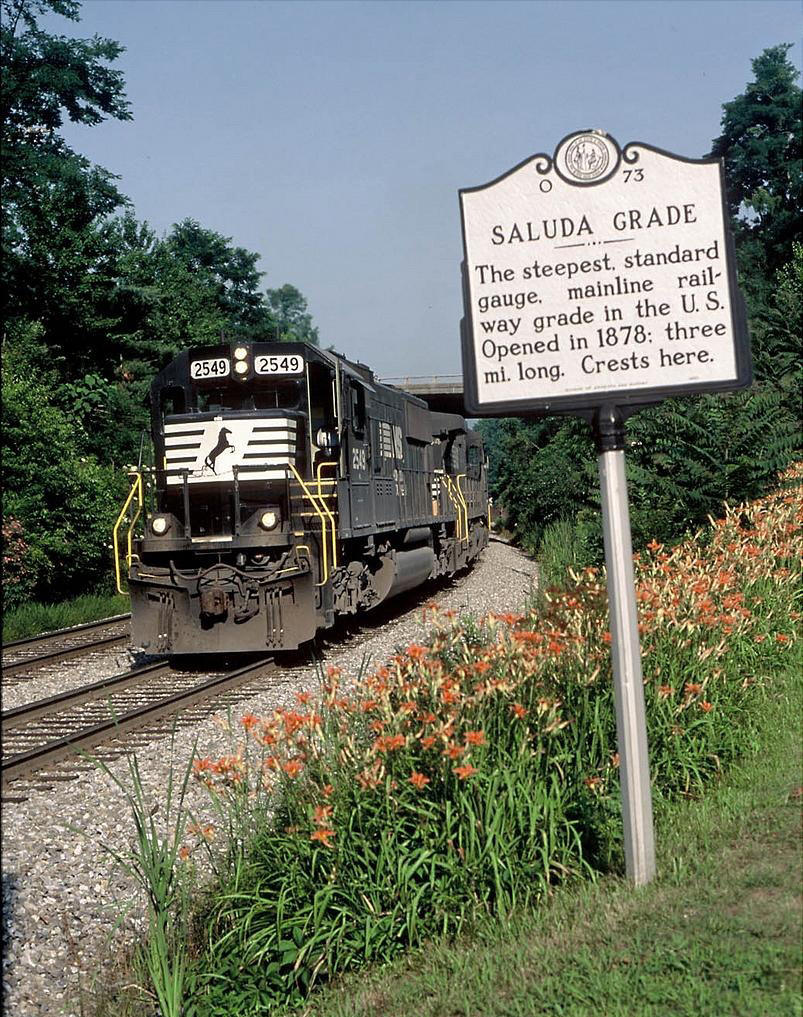 Norfolk Southern SD70 #2549 nears the summit at Saluda, North Carolina to fetch another cut of cars as it passes the grade's historic marker on June 22, 1996. Wade Massie photo.
Norfolk Southern SD70 #2549 nears the summit at Saluda, North Carolina to fetch another cut of cars as it passes the grade's historic marker on June 22, 1996. Wade Massie photo.Operation
The route was officially open on the morning of July 4, 1878. Over the years to improve the safety of the line it had various intervals of what were essentially manned runaway tracks in the event an eastbound train out of Asheville lost its brakes.
Before the days of radio, these manned runaway turnouts required the train to give off a coded whistle to signal those stationed at each location to open the line for through traffic. This practice was carried on through the Southern, and even Norfolk Southern era.
Safety Features
Centralized Traffic Control (CTC) signaling was installed over the Saluda Grade in the 1950s to enhance safety. This technology was a significant improvement over its precursor, manual block signaling. Despite these safety improvements, the maximum speeds allowed over the line for safety reasons remained definitively low, generally under 8 miles per hour.
CTC, coupled with automated switches and timer circuits, helped ensure that trains moving downgrade moved no faster than 8 mph. If not, assuming the train was not under control, the runaway safety track at the bottom of the grade in Melrose was triggered.
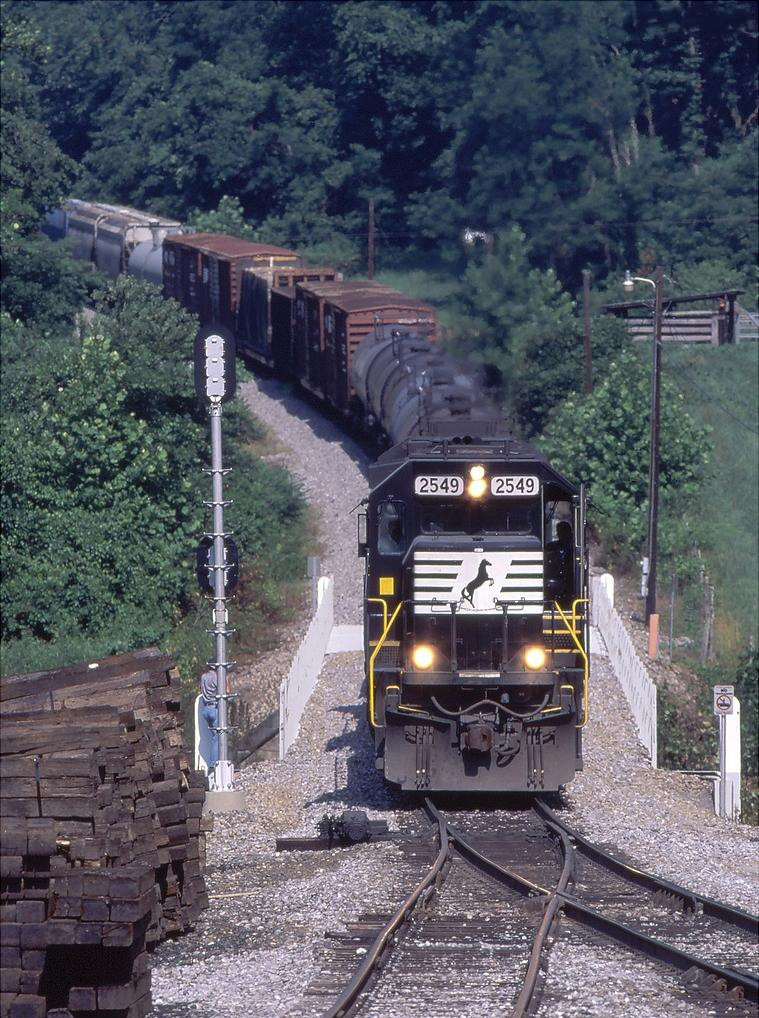 Norfolk Southern SD70 #2549 eases freight W78 down Saluda Grade and nears the Melrose Safety Spur on June 22, 1996. Wade Massie photo.
Norfolk Southern SD70 #2549 eases freight W78 down Saluda Grade and nears the Melrose Safety Spur on June 22, 1996. Wade Massie photo.Closure
Interestingly, while runaways on the route did occur and a few crewmen lost their lives, no passenger trains ever recorded a fatality.
According to the Southern Railway's 1969/70 timetable the exact distance between Spartanburg and Asheville is 68.5 miles (or between Milepost 181.5 at Asheville to milepost 250.0 at Spartanburg).
In an attempt to reduce operating costs successor Norfolk Southern mothballed Saluda Grade in late 2001 with the final train running the line on December 9th that year.
While there was talk of reopening the route over, most likely in the event of needed capacity but given the line's severe grades and expensive operating costs it is doubtful that will ever happen. To date, however, Norfolk Southern retains full ownership of the property.
Rail Trail
On July 20, 2022 the Greenville Journal reported that rail/trail coalitions Conserving Carolina, PAL; Play, Advocate, Live Well; and Upstate Forever, made an undisclosed offer to Norfolk Southern for acquisition of line over Saluda Grade.
The corridor would then be converted into a rail/trail known as the Saluda Grade Rail Trail. It will cover 31 miles in all with 16 miles in South Carolina and the remaining 15 miles in North Carolina.
The trail would pass through the towns of Inman, Campobello, Landrum, Tyron, and Saluda with the northwestern terminus being situated near Hendersonville.
The loss of this corridor as a rail artery would certainly be a blow to train enthusiasts and historians although its prospects as a profitable route are slim in the modern day.
The line is extremely expensive to operate and there is little online traffic in the immediate area. Nevertheless, the prospects of Norfolk Southern letting go of a through route are equally slim during a time when reactivating an abandoned line is almost unheard of.
Legacy
The Saluda Grade, with its steep pitches and sharp curves, was an engineering marvel of its time. It served as a vital cog in the Southern Railway's operations, linking the Piedmont Region of South Carolina to the Appalachians.
Operating the Saluda Grade required tremendous skill and nerve. Train crews and engineers had to navigate intense inclines, often relying on helper engines to push trains up the grade or employing safety measures such as "safety tracks" to stop runaway trains.
Despite these safety precautions, the Saluda Grade was the site of numerous accidents over the years. Its infamy was such that the railroad often tried conducting operations on the grade during the night, reducing the chance of spectators gathering to watch trains climb its remarkable slope.
During its operating era, Saluda Grade was both admired and feared by railroaders. Despite the inherent difficulties it presented, it was also a symbol of railroading's immense capabilities and resilience.
The notoriously steep grade and perilous conditions made this short stretch of track an icon in the world of railroading. It became both a technical challenge and a symbol of the determination to overcome daunting geographical obstacles.
The discontinuation of service over the Saluda Grade marked the end of a significant chapter in American rail history. It's still remembered by older rail workers for its steep slopes, perilous descents, and the unique skill set it demanded.
Since the cease of rail activity, the Saluda Grade has mostly lain silent. Its rail ties and tracks, once gleaming with the constant chug of steel wheels, now lie quiet, a testimony to a time when steel, steam, and grit combined to conquer geographic barriers.
While it's been several years since the last freight run, local interest in Saluda Grade has not waned. The proposed "Saluda Grade Rail Trail" project sparked significant local enthusiasm. Transforming the abandoned rail line into a recreational trail would have substantial benefits, not just as a historical tribute but also as a potential boost for local tourism and economy.
Though dormant, the spirit of the Saluda Grade endures. It remains a powerful symbol of Southern Railway's commitment to overcoming challenges and its pivotal role in fueling regional growth during the late 19th and early 20th centuries.
The planned Saluda Grade Rail Trail signifies a new chapter for this historic railway line. It's an opportunity to respect and remember the triumphs and challenges of the past while embracing a new era of engagement with the local community and the natural beauty of the region.
In conclusion, Saluda Grade personifies a critical era in the annals of American railroad history. Its legacy, a testament to the formidable engineering feats of Southern Railway and the tenacity of the workers that made it possible, continues to captivate the imagination of rail enthusiasts and historians. Despite its challenges, the Saluda Grade's story is a testament to human ingenuity, determination, and the romantic lure of the rails.
Recent Articles
-
Georgia Christmas Train Rides In Blue Ridge!
Dec 20, 25 01:26 PM
Each holiday season, the Blue Ridge Scenic Railway transforms into the Holiday Express—a cheerful, family-friendly journey designed to wrap you in the sights and sounds of Christmas. -
Florida Christmas Train Rides In Parrish!
Dec 20, 25 01:19 PM
While the museum operates excursions throughout much of the year, its most beloved event arrives with twinkling lights and cooler breezes: the North Pole Express, a holiday train ride that’s become a… -
Michigan - Wine Tasting - Train Rides
Dec 20, 25 09:58 AM
In this article, we’ll delve into the world of Michigan’s wine tasting train experiences that cater to both wine connoisseurs and railway aficionados.

